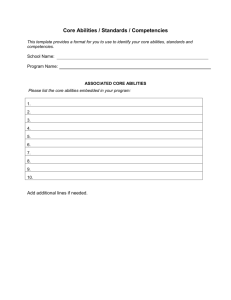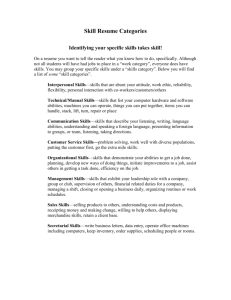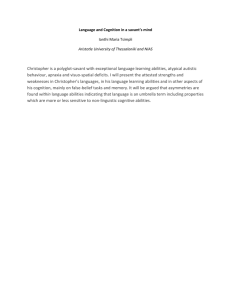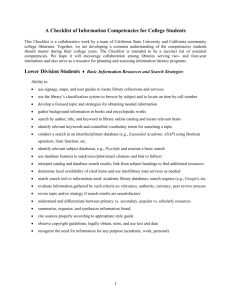Managing Change - North Carolina Library Association
advertisement
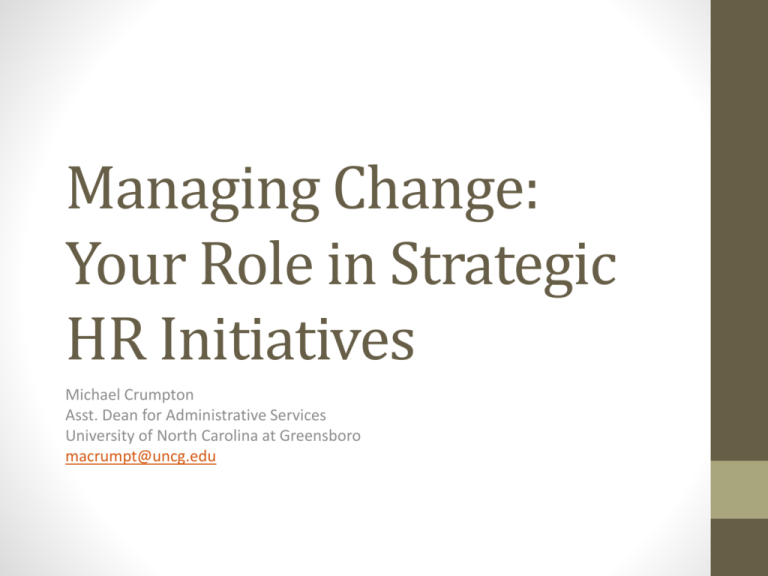
Managing Change: Your Role in Strategic HR Initiatives Michael Crumpton Asst. Dean for Administrative Services University of North Carolina at Greensboro macrumpt@uncg.edu Enduring Values • Stewardship • Service • Intellectual freedom • Rationalism • Literacy and learning • Equity of access • Privacy • Democracy • Common good IFLA Trends Report Our information environment is constantly changing. How will we access, use and benefit from information in an increasingly hyperconnected world? The IFLA Trend Report identifies five top level trends which will play a key role in shaping our future information ecosystem: • TREND 1: New Technologies will both expand and limit who has access to information. • TREND 2: Online Education will democratize and disrupt global learning. • TREND 3: The boundaries of privacy and data protection will be redefined.. • TREND 4: Hyper-connected societies will listen to and empower new voices and groups. • TREND 5: The global information environment will be transformed by new technologies. Information Literacy and Information Technology "Fluency" with information technology may require more intellectual abilities than the rote learning of software and hardware associated with "computer literacy", but the focus is still on the technology itself. Information literacy, on the other hand, is an intellectual framework for understanding, finding, evaluating, and using information--activities which may be accomplished in part by fluency with information technology, in part by sound investigative methods, but most important, through critical discernment and reasoning. Information literacy initiates, sustains, and extends lifelong learning through abilities which may use technologies but are ultimately independent of them. Role(s) of Libraries Historically • Self-improvement • Social harmony • Growth and development • Multicultural • Intellectual freedom New or current • • • • • Community building Maker Movement Economic impact Technology Information literacy in a global society Information Communities • Includes Role of Information • Diverse information providers • People’s need for access and use of information • Impact of emerging technologies • Transcending barriers • Foster social connectedness Dimensions of Diversity Organizational Kudzu Kudzu growth peaks HR Focus: Staffing Staffing and Compensation, HR planning, training training Crisis: Bureaucracy Crisis: Delegation Crisis: Leadership Need: Creativity Introduction Crisis: Change resistance Need: Formal systems Need: Clear direction Growth Change management Outplacement Cross-training Maturity Need: • Streamlined decision making • Flexibility • Small-company thinking Decline Internal SWOT Strengths Weaknesses • Open to New Ideas • Embrace Learning • Closed to New Ideas • Non-Inclusiveness SWOT External Opportunities • Skill Development • Training • Available Talent Threats • Position Freezes • Retention Issues Competencies Competencies are a set of behaviors encompassing skills, knowledge, abilities and personal attributes that, taken together, are critical to successful work accomplishment. -Society of Human Resource Management Using Competencies Hiring Process • Job descriptions and responsibilities • Classifications and/or upgrades • Expand services or support structure • Increases or changes to staffing structure Performance Management • Evaluations and Reviews • Training or professional development • Improve services or service offerings • Address new technologies or responsibilities Examples • Technology • Word processing, spreadsheets, presentation programming skills • Web navigation and design skills • Digitization, camera • File management skills • Videoconferencing • Local network knowledge • Storage devices 12 Core Competencies As identified by: BETH McNEIL AND JOAN GIESECKE • • • • • • • • • • • • analytical skills/problem solving/decision making communication skills creativity/innovation expertise and technical knowledge flexibility/adaptability interpersonal/group skills leadership organizational understanding and global thinking ownership/accountability/dependability planning and organizational skills resource management service attitude/user satisfaction Importance of Building Competencies • Focusing on competencies • Positive impact on diversity • Supports change • Organizational development initiatives • Emotional intelligence component • Manages self • Understands others • Better relationships Building Competency Models • Determine business need • Functions and stakeholders • Job analysis • User benefits • Gather data • Project gaps • Develop plan and vision • Gather support • Launch and evaluate KSA’s KSAs...Knowledge, Skills and Abilities...a list of special qualifications, experiences and personal attributes that you need to have for a particular job. Knowledge • Knowledge statements refer to an organized body of information usually education or from a factual or procedural nature which, if applied, makes adequate performance on a job possible. A body of information applied directly to the performance of a function. Skills • Skills refer to the proficient manual, verbal or mental manipulation of data or things. Skills can be readily measured by a performance test where quantity and quality of performance are tested, usually within an established time limit. Examples of proficient manipulation of things are skill in typing or skill in operating a computer. Examples of proficient manipulation of data are skill in computation using decimals; skill in editing for transposed numbers, etc. Abilities • Ability statements refer to the power to perform an observable activity at the present time. This means that abilities have been evidenced through activities or behaviors that are similar to those required on the job, e.g., ability to plan and organize work. Abilities are different from aptitudes. Aptitudes are only the potential for performing the activity. Stakeholders Perspective Does the vision and strategy meet the needs and expectations of stakeholders such as students, faculty, community and staff? Operations and Services Perspective Financial Perspective Is budgeting strategically focused on a mix of elements that support the library’s vision and strategy while remaining sustainable? VISION AND STRATEGY Learning & Growth Perspective Does the library promote and encourage innovation and creativity with ongoing learning opportunities for collective growth? Are operations and processes streamlined for efficiency and job satisfaction for library staff? People • • • • Talent Acquisition Retention Efforts Employee Engagement Professional Development • Benefit Administration Organization • Provide Structure for Organizational Guidelines • Organizational Effectiveness Planning • Workforce Management and Disciplines • Employee Relations Workplace • Diversity and Inclusion Issues • Risk Management • Institutional Social Responsibility • Employment Law and Regulations Strategy • Institutional Vision and Strategic Direction • Institutional Values Strategic Positioning Trends and Emerging Concepts • Skills Assessment • Contingency Plans Departmental Job/ Task Analysis • Task Prioritized • Unit of measurement = hours Skills Development • Options Provided • Training Documented Performance Plan’s • Catalyst for Changes Repurposed Position Model Desired Position Identified Solicit Internal Interests • Positions identified in trends review as needed by organization to move forward • Internal posting process to move existing line to new department (internally) • Interested persons will be interviewed by group with established criteria • Successful candidate’s department review of incumbent position • Determine if responsibilities are absorbed or if another posting is required • Training plan created for successful candidate in new department Interview Process Department Reviews and Creates new Desired Position Candidate Recommendation Yes Critical to Current Dept.? No Department Absorbs Responsibility Strategy Process Environmental scanning, SWOT, Benchmarking Monitor progress and adjust as needed Strategic vision or mission Implement the strategy Strategy development Gathering Information Factors to consider Position purpose, relationship to other positions in work area Responsibilities and activities of people currently in position Knowledge, skills and abilities that are needed for success Behaviors and performance expectations for individual in position Methods for analysis Observation Uses of the information Position descriptions and organizational fit Interview Expectations or performance for position Training or development needs of individuals in position Recruitment specs or career progression/succession planning criteria Questionnaires Dairies and logs LIBRARY CAREER LATTICE Other Educational Career Path Library/Information Science Career Path Senior Librarian Senior Specialist Librarian Specialist LIS Associate Associate Specialist LIS Associate Assistant Specialist Clerk Change management model 7. Implement and evaluate the change. 1. Determine the need or desire for change. 6. Communicate the change. 2. Prepare tentative plans. 5. Establish a project plan and a timetable. 3. Discuss alternatives and probable reactions. 4. Make a final decision. goals Facilitate Changes • What has changed lately…….look at tasks and job functions • Technology – is everyone keeping up? • Are changes transparent? Do you know what your neighbor is doing? • • • • Team Building Are cross department teams formed for org projects? Are they always the same people? Anyone feeling left out? Are team leaders formal or informal? Are contributions recognized? goals • • • • Performance Management Democratic vs. autocratic organization – pros and cons Subject specialist as managers Evaluation methods used Value of peer review? • • • • Goal Planning Institution goals and mission statement Individual goals for annual review Department goals for group actions Project team goals for focused results Doing your research Primary • • • • • • • (data gathered firsthand) Experimental Pilot projects Surveys Interviews Focus groups Direct observation Testing Secondary • • • • • • (data gathered by others) Secondhand reports Historical data Purchased data Professional publications Benchmarking Best-practices reports Creating next expectation • Staff are “introduced to new skills • Research will be conducted on feedback • Action items will be implemented • Programs will be expanded and repeated • Assessment tools used to quantify results • Transparency important for sharing


